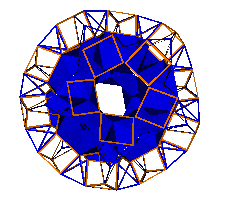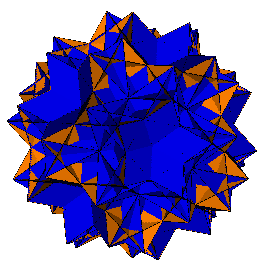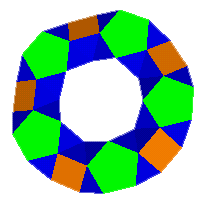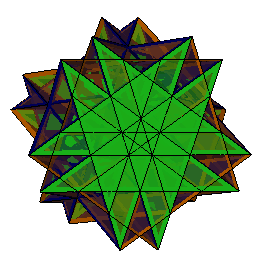

I am repeatedly amazed by the number of polyhedra that have 'great' isomorphs. I have yet to see a formal definition 'great' when applied to polyhedra, but my understanding of it is that certain polygons such as {5}, {8}, or {10}-gons can be replaced by {5/2}, {8/3} or {10/3}-gons respectively, vertices are crossed and the symmetry of the original figure retained. I am aware though that this prefix is normally reserved for Uniform Polyhedra.
 |
 |
In investigating the Stewart Toroid T5 / 12 Q5S5 (D5) (above left) , I was delighted to discover that even Stewart Toroids can have 'great' isomorphs. In the same way that a truncated dodecahedron can be tunnelled by twelve pentagonal cupolas and twelve pentagonal antiprisms, with a central dodecahedron then removed, then a great stellated truncated dodecahedron (with vertex figure 10/3,10/3,3) can be 'drilled' by twelve {5/3}-cupolas, and twelve {5/3}-antiprisms (these are retracted) with the final removal of a central core of a great stellated dodecahedron. Like the original figure, it is also genus 11. In pseudo-Stewart terminology, you have a tE* / 12 Q{5/3}S{5/3} (E*) (above right). This is isomorphous to the original Stewart Toroid.
 |
 |
Again like the original figure it contains the L1-L1' and L2-L2' layers. A fascinating figure can be obtained by taking the slice between the L2-L2' layers and filling the holes with pentagrams (above right). As a toroid it seems slightly disappointing but I like the 'fractal-like' appearance of the overlapping pentagrammic faces.